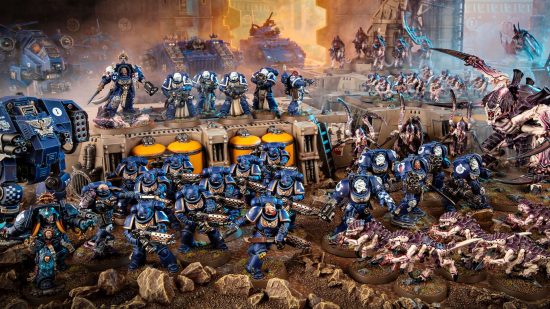Wargamer was lucky enough to receive a copy of the Warhammer 40k 10th edition core rules, courtesy of Games Workshop, in advance of the Leviathan box set release. Some of these rules have been revealed on the Warhammer Community website already, but there’s still much about the new edition of Warhammer 40k that could trip up an unsuspecting gamer, even if you’ve kept up with every article.
The core rules are only half the picture for Warhammer 40k 10th edition, of course, as we’re still waiting to see the full roster of datasheets for every Warhammer 40k faction. You can get your hands on the new rules for Warhammer 40k 10th edition from the Games Workshop website – stay alert for these changes and more as you read through!
Here are 10 surprises from the Warhammer 40k 10th edition core rules:
You can shoot at Vehicles and Monsters in combat
The Big Guns Never Tire rule still allows Vehicles and Monsters to fire their guns into enemy units they’re engaged with, with a -1 to hit penalty, as it did in ninth. Now other unengaged units can return the favour, targeting a Monster or Vehicle engaged with ranged weapons and the same -1 penalty to hit. In both instances you’re not allowed to fire Blast weapons into a combat.
Grenades are a Core Stratagem, not wargear
For 1CP, a unit with the Grenades keyword can target a visible enemy unit within 8”, and roll six dice. Each 4+ turns into a mortal wound. Simple.
Tank Shock is back as a Core Stratagem
For 1CP, after a vehicle charges you can roll a number of D6 equal to the Strength characteristic of one of its weapons, adding two dice if that exceeds the charge target’s toughness. Every 5+ becomes a mortal wound (up to a maximum of six mortal wounds).
This looks hilarious. Games Workshop has already revealed Datasheets for Imperial Knights and Chaos Knights wielding S20 melee weapons. Opening a combat with six pretty-much guaranteed mortal wounds on anything lighter than a Space Marine Gladiator seems like a great way to spend 1CP.
You can use Overwatch any time an enemy moves
We learnt about this during our demo game of 10th edition at Warhammer Fest, but now we’ve seen the core rules we’ve got more details on how it works. Any time an enemy unit starts or ends any kind of move or charge, you can target them with a unit within 24”. That unit gets to shoot, hitting on sixes. A special restriction notes that you can only use this stratagem once per turn.
More units can make Heroic Interventions
Heroic Interventions are no longer part of the core combat rules for characters. Instead, for 2CP, when an enemy completes a charge move within 6” of one of your units, it can make a counter charge.
The unit has to be eligible to do so, so Aircraft are ruled out, as are units locked in combat. The counter-charger doesn’t get the Fights First bonus for charging, either. Walker vehicles are permitted to Heroically Intervene, but not other kinds – a shame for fans of that one Horus Heresy book where Khârn the Betrayer gets run over by a Land Raider.

Challenges are back
The Leader ability means that once a character is attached to a Bodyguard unit, it cannot be allocated wounds until its Bodyguard is dead. The only way to scalpel it out of the unit is to attack with Precision weapons that can force wounds to be allocated to the character. And for 1CP, the Epic Challenge Core Stratagem grants one of your characters Precision melee attacks.
Defenders who Fight First go before chargers
The fight phase is now split into two steps: the Fights First step for Chargers and units with a Fights First ability; and the Remaining Combats step. In each step, players pick units to fight alternately, starting with the player whose turn it isn’t (ie, the defending player).
There wasn’t an official ‘Fight First’ step in ninth edition 40k, but the rare rules covering Fights First abilities gave priority to the player taking their turn, which meant a charging attacker trumped a defender that could Fight First. That’s changed, making it incredibly hard to get the drop on units that can Fight First in melee.
The rules for consolidation are stricter
Another rule we saw in our preview game at Warhammer Fest that’s likely to trip up players making the move from 9th to 10th edition: after a unit has fought in combat it can consolidate up to 3”, but only if it uses that movement to get more deeply stuck into the enemy it’s fighting, engage a new enemy, or claim an objective.
Strategic reserves let ¼ of your army outflank
Up to ¼ of the points for your army can be placed into Strategic Reserves during deployment. Unlike the core rules for 9th edition, this has no CP cost. From turn two onwards they can deploy during your Reinforcements step within 6” of your battlefield edge or either flank, and from turn three they can appear in your enemy’s backfield.
There’s no global maximum to the number of units you can put into Reserves: the Strategic Reserves limit is in addition to any other form of Reserves, like Deep Strike or Aircraft. That’s just in the core rules, of course, and matched play mission packs may have their own limits.
Aircraft have a minimum movement, but not a maximum
Speaking of Aircraft, most of these rules are the same, but Aircraft no longer have maximum movement speeds. In most home games of 40k that won’t matter, but for massive participation games at Warhammer World or on huge convention tables, your Stormravens and Hemlock Wraithfighters will now be able to cross the length of the battlefield in the blink of an eye.
If you’re interested in knowing why the game has been pushed in one direction and not another, check out Wargamer’s interview with Warhammer 40k Studio Manager Stuart Black in which he discussed his goals for the new edition.






